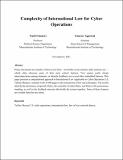| dc.contributor.author | Choucri, Nazli | |
| dc.contributor.author | Agarwal, Gaurav | |
| dc.date.accessioned | 2022-04-07T15:12:28Z | |
| dc.date.available | 2022-04-07T15:12:28Z | |
| dc.date.issued | 2021-11-08 | |
| dc.identifier.uri | https://doi.org/10.1109/HST53381.2021.9619833 | |
| dc.identifier.uri | https://hdl.handle.net/1721.1/141741 | |
| dc.description.abstract | Policy documents are usually written in text form—word after word, sentence after sentence etc.— which often obscures some of their most critical features. Text cannot easily situate interconnections among elements, or identify feedback, nor reveal other embedded features. This paper presents a computational approach to International Law Applicable to Cyber Operations 2.0, Tallinn Manual, a seminal work of 600 pages at the intersection of law and cyberspace. The results identify the dominance of specific Rules, the centrality of select Rules, and Rules with autonomous standing, as well as the feedback structure that holds the system together. None of these features are evident from the text alone. | en_US |
| dc.description.sponsorship | This material is based on work supported by the MIT Political Science Department & U.S. Department of Defense. Any opinions, findings, conclusions or recommendations therein are those of the author(s) and do not necessarily reflect the views of the U.S. Department of Defense. | en_US |
| dc.language.iso | en_US | en_US |
| dc.publisher | © IEEE | en_US |
| dc.rights | Attribution-NonCommercial-NoDerivs 3.0 United States | * |
| dc.rights.uri | http://creativecommons.org/licenses/by-nc-nd/3.0/us/ | * |
| dc.title | Complexity of International Law for Cyber Operations | en_US |
| dc.type | Article | en_US |
| dc.identifier.citation | Choucri, N., & Agarwal, G. (2021). Complexity of international law for cyber operations. Proceedings of the 2021 IEEE International Symposium on Technologies for Homeland Security (HST), 1–7. | en_US |
| dc.eprint.version | Author's final manuscript. | |
